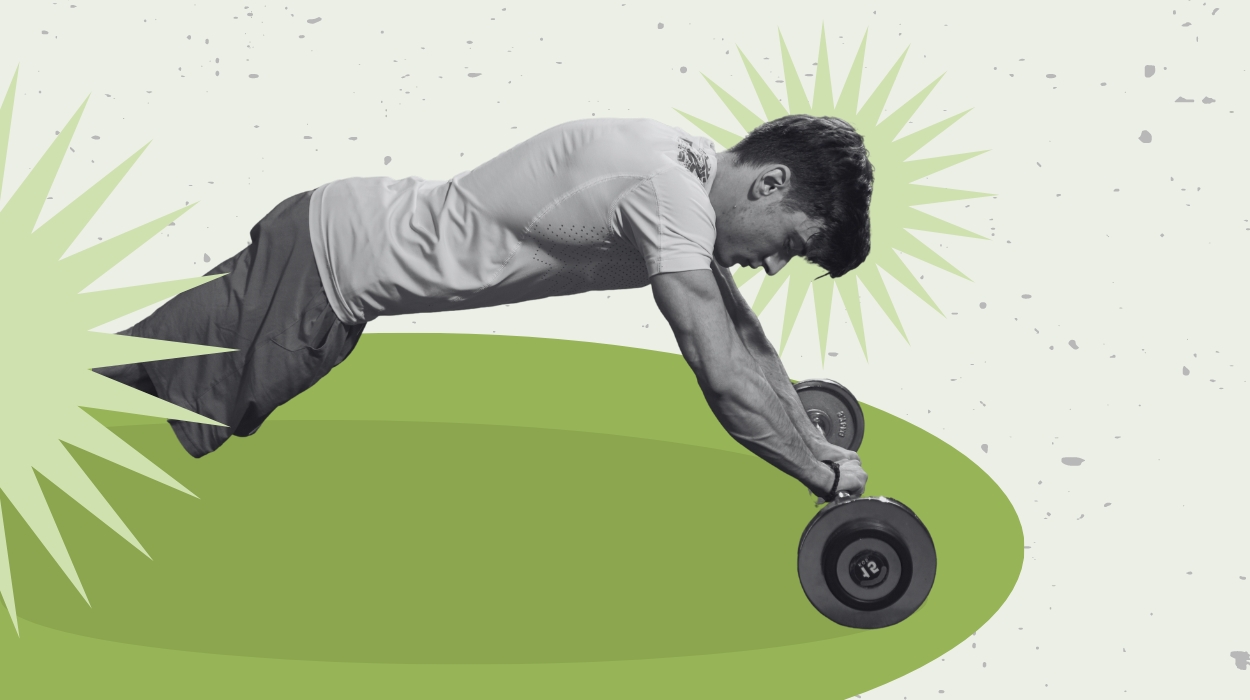
Pursuing sculpted abs makes it easy to gravitate towards countless crunches, fat burners, or the latest ab gadget. However, the humble barbell or barbell ab workouts, often associated with bicep curls and squats, have powerful potential to boost your core strength, carve your abs, and elevate your overall fitness game.
Get ready to explore the untapped power of ab workouts with barbells, torch your core, and pave the way for the physique you’ve dreamed of.
Best Hard Core Exercises To Build A Strong Core
Best Barbell Ab Workouts To Try In 2024
We offer a selection of barbell-based movements that focus on strengthening your core. These exercises are designed to enhance core stability and overall strength, making them valuable additions to your fitness routine.
Barbell Rollout
This targets your entire core and enhances your stability and balance.
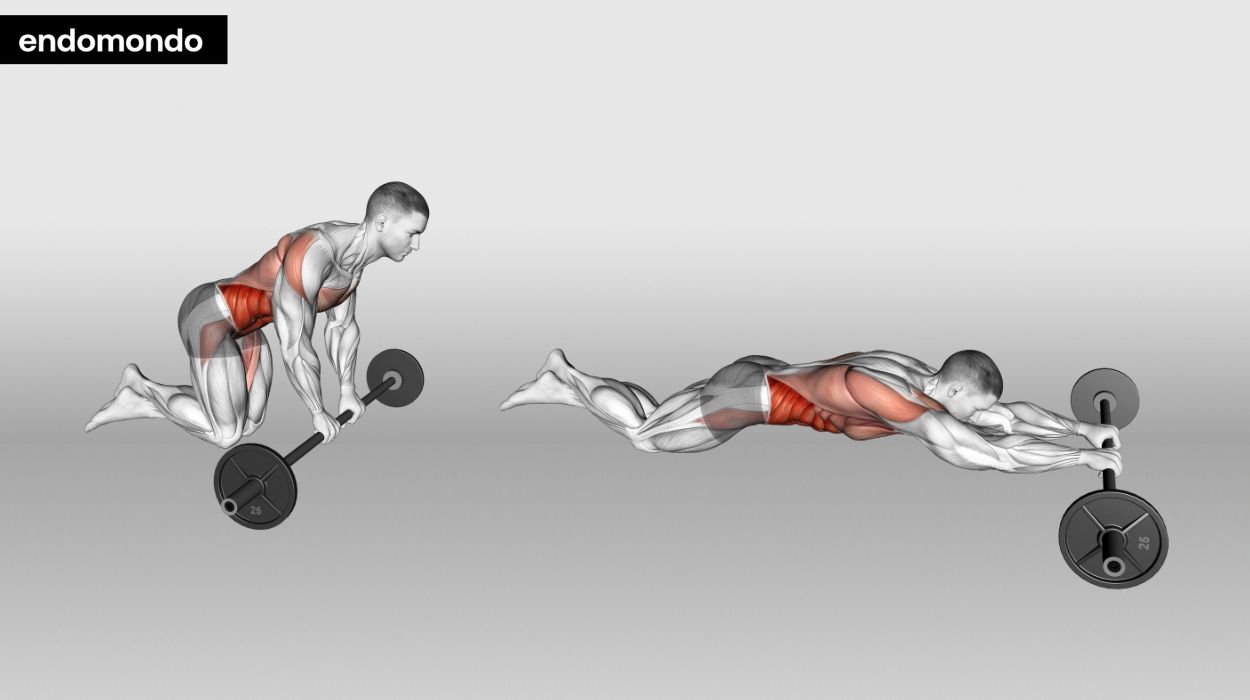
How to do:
- Kneel on the floor.
- Grip the barbell with your hands shoulder-width apart and roll it forward until your body is extended.
- Keep your arms straight.
- Roll back to the starting position.
Tips:
- Control the rollout by exhaling as you extend forward and inhaling as you return to the starting position.
- Use an ab wheel or similar equipment for added stability and control if you’re a beginner.
- Gradually increase the range of motion as your core strength improves, but avoid overstretching to maintain proper form.
Optimal Sets and Reps: 2-3 sets of 10-15 reps.
Landmine 180
Your obliques strengthen, engaging your entire core and promoting rotational strength and endurance.
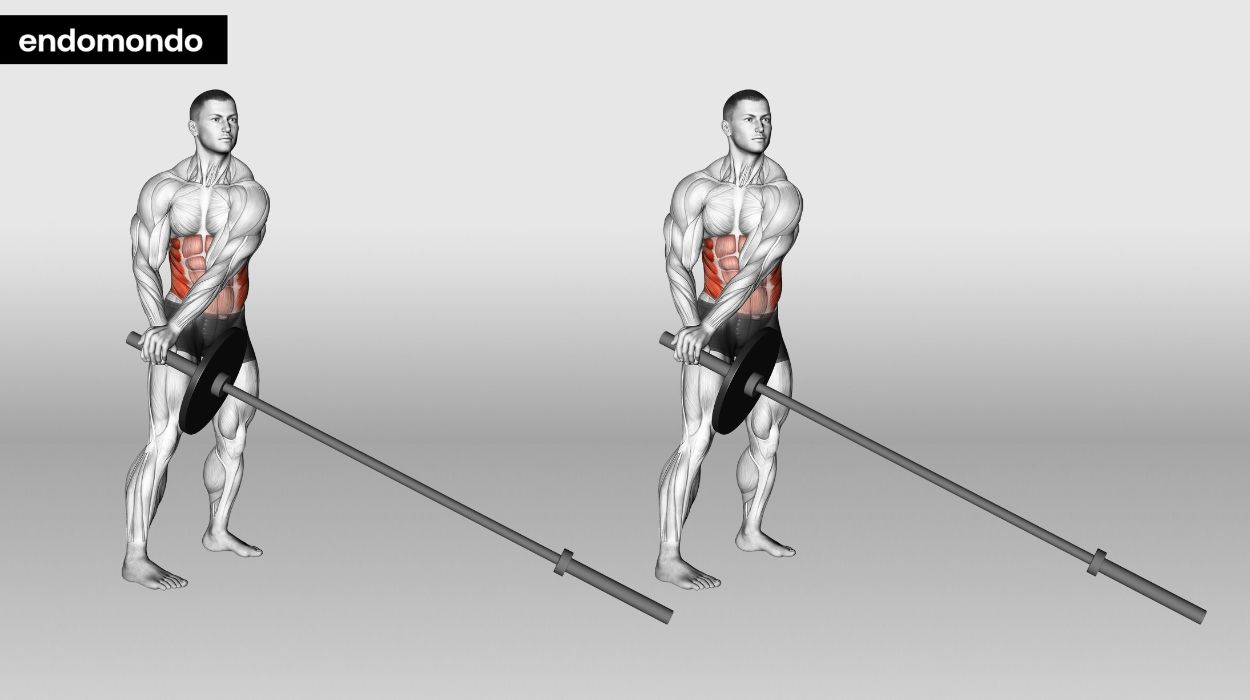
How to do:
- Position a barbell in a landmine holder at the gym or in the corner of a room to secure it.
- Stand over the barbell and lift it to your chest.
- Rotate your torso from one side to the other in a semi-circular motion to complete one rep.
Tips:
- Start with a lightweight and master the movement’s technique before adding more resistance.
- Keep your core engaged and your back straight throughout the exercise to protect your spine.
- Use controlled rotational movements to avoid straining your lower back.
Optimal Sets and Reps: 2-4 sets of 8-12 reps.
Barbell/EZ Bar Russian Twist
This targets the obliques and can improve rotational power and overall core strength.
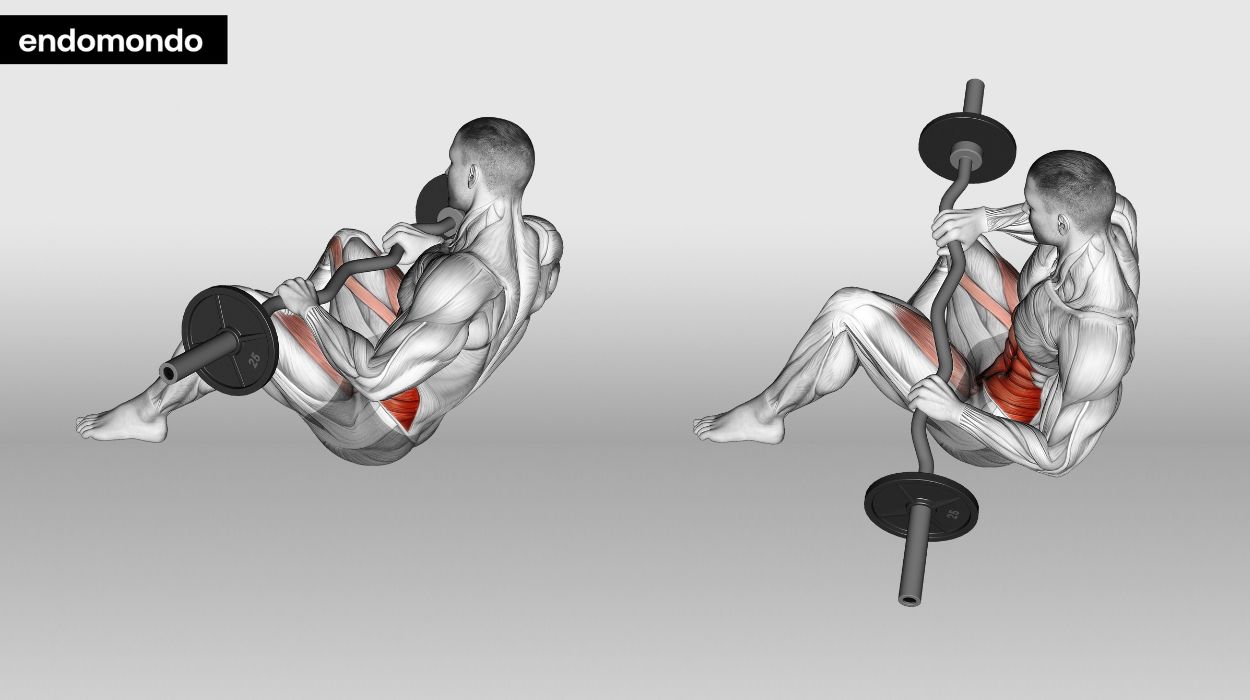
How to do:
- Sit on the floor with your knees bent and hold a barbell with your hands at your chest.
- Lean back slightly and twist your torso from side to side, touching the barbell to the floor on each side.
Tips:
- Maintain a steady pace and control the movement to engage your oblique muscles effectively.
- Keep your feet flat on the ground or elevate them for added challenge, depending on your fitness level.
- Breathe rhythmically, exhaling as you rotate and inhaling as you return to the center to maintain stability.
Optimal Sets and Reps: 2-3 sets of 10-15 reps.
Barbell Ab Rollout On Toes
This exercise is similar to the barbell rollout but performed from a toes-planted position rather than kneeling. It enhances overall core stability and strength, particularly the lower abs.
How to do:
- Kneel on the floor, and grip the barbell with your hands shoulder-width apart.
- Lift your knees so they no longer support your weight.
- Roll the barbell forward until your body is extended.
- Keep your arms straight.
- Roll back to the starting position.
Tips:
- Ensure a straight line from head to heels, engaging your core to protect your lower back.
- Keep your shoulders directly over your wrists to distribute the weight evenly.
- Use controlled movements and a stable barbell to prevent accidents and maximize effectiveness.
Optimal Sets and Reps: 2-3 sets of 8-10 reps.
Overhead Squat
A challenging full-body exercise that combines strength, balance, and flexibility.

How to do:
- Standing tall, grasp a barbell with a wide grip. The exact width will vary depending on your body proportions and shoulder flexibility, but it should be wider than your shoulders.
- Lift the barbell overhead with your arms extended. Your elbows should be fully locked out.
- Stand with your feet shoulder-width apart. The bar should be directly above or slightly behind your head, and your chest should be up and your shoulders back. Brace your core, keep your back neutral, and look straight ahead.
- Start by bending at your hips and knees to descend into a squat.
- Keep your heels planted firmly on the ground and your knees aligned with your feet.
- As you lower yourself, ensure that your arms remain straight and the bar stays in the same position relative to your body. Your goal is to keep the bar over your mid-foot throughout the movement.
- Go as low as possible while keeping your chest up, back straight, and heels on the ground. It would be best if you squatted until your hips were below your knees.
- Push your body up again once you’ve reached the bottom of the squat. Drive through your heels, and straighten your hips and knees to stand up, maintaining the bar’s position overhead. Keep your core engaged and your chest up throughout this part of the move.
- Once you’re standing up straight again, you’ve completed one overhead squat.
Tips:
- Ensure a solid shoulder and upper back mobility before attempting this exercise.
- Maintain a straight back and engage your core to protect your spine during the squat.
- Start with a lighter weight to master the form before progressing to heavier loads.
Optimal Sets and Reps: 2-4 sets of 5-12 reps.
Barbell Suitcase Deadlift
This type of deadlift enhances internal and external obliques and core stability while improving balance.
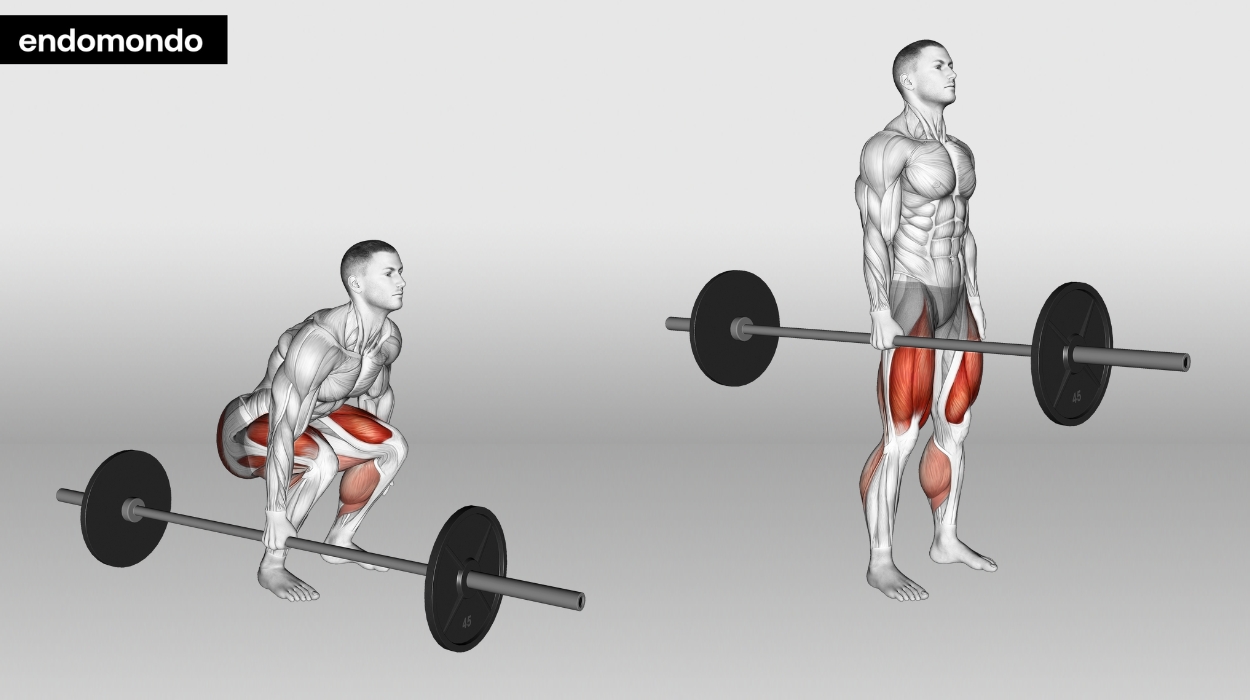
How to do:
- Stand with feet shoulder-width apart beside a barbell.
- Bend down, keeping your legs straight, and lift it with one hand like you would a heavy suitcase.
- Complete 10-15 reps in a set before switching sides.
Tips:
- Focus on keeping your shoulders square and your chest up throughout the movement.
- Brace your core as you lift and lower the weight to maintain stability.
- Gradually increase the weight as your strength improves, ensuring that you can maintain proper form.
Optimal Sets and Reps: 2-3 sets of 10-15 reps.
Barbell Hip Thrust
A powerful lower body exercise, the Barbell Hip Thrust focuses on strengthening your glutes and hamstrings
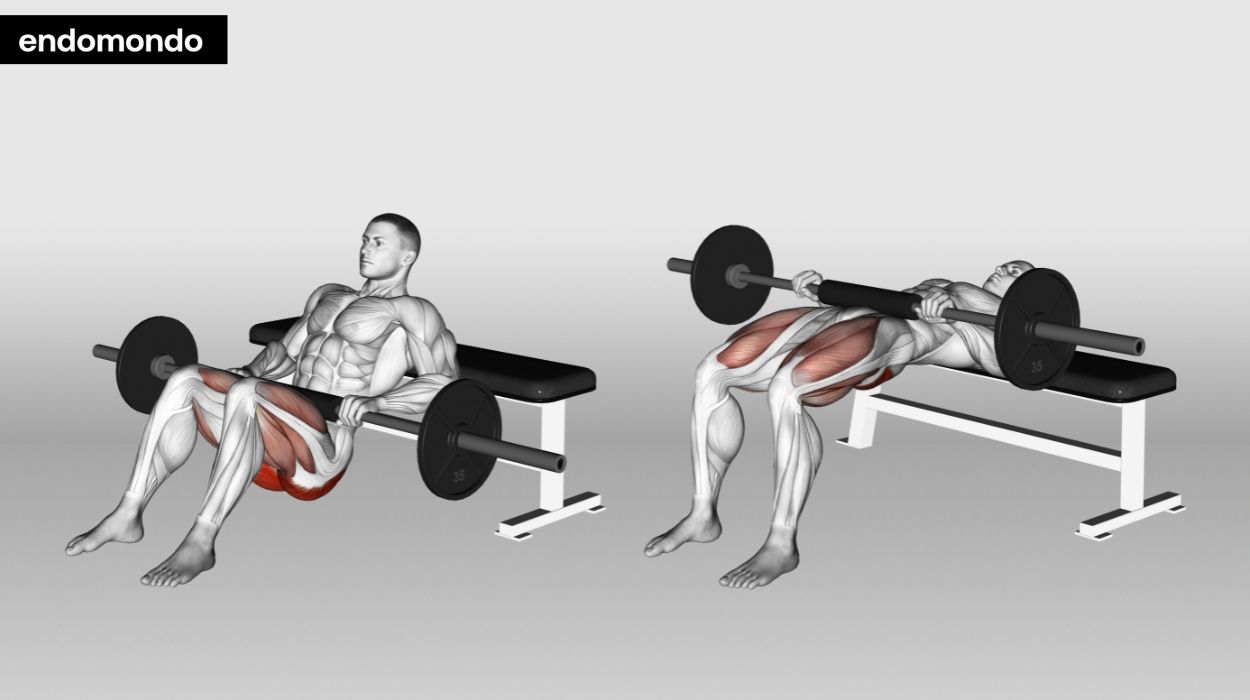
How to do:
- Sit on the ground with your shoulder blades against a bench, your legs extended, and a barbell on your lap.
- Push through your feet and lift your hips until they’re in line with your body, reaching the height of the bench — perpendicular to the floor.
Tips:
- Use a padded barbell pad or towel to protect your hips and ensure comfort.
- Keep your neck relaxed and gaze forward to maintain proper head and spine alignment.
- Start with a manageable weight and gradually progress to avoid straining your lower back.
Optimal Sets and Reps: 2-3 sets of 6-12 reps.
Benefits Of Barbell Ab Exercises
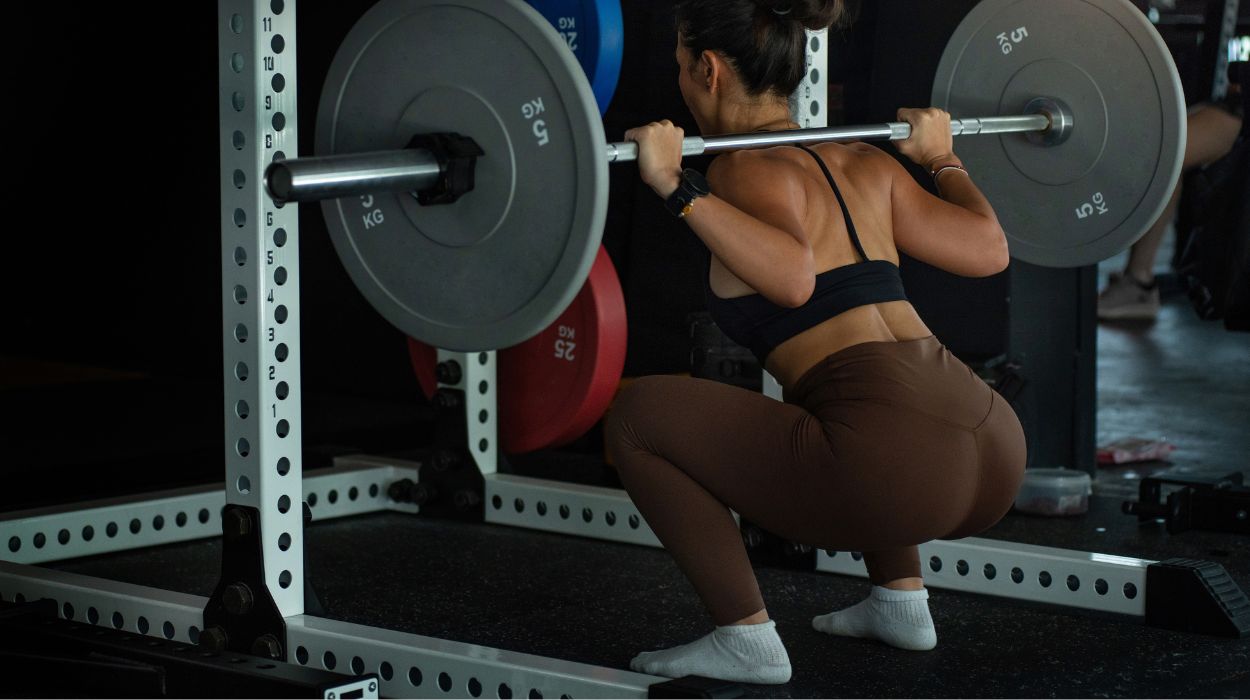
Here are some of the main benefits of ab training using barbell exercises:
Full Body Conditioning
An ab workout with the barbell (or dumbbell workout) engages multiple muscle groups simultaneously, increasing total body strength and coordination.
Core Stability And Strength
Despite being often overlooked in ab-centric workouts, the barbell is a great tool for enhancing core strength.
High-Calorie Burn
Barbell abs exercises offer compound movements. These are typically high-intensity and engage large muscle groups. This leads to a higher calorie burn during your workout and an increased metabolic rate post-workout.
Progressive Overload
Weighted ab workouts make it straightforward to apply the principle of progressive overload[1] – gradually increasing the stress placed on your body through exercise.
Versatility
The range of exercises you can perform with a barbell is vast. From deadlifts to squats, presses to rows, the barbell can effectively train every part of your body, including your abs.
Whether you’re a newbie or a seasoned gym-goer, ensure you perform these core exercises with the barbell correctly and with the proper form to avoid injury.
Safety Tips
Warm Up
Before diving into any core training exercise, take 5-10 minutes to warm up your muscles and joints with light cardio and dynamic stretches. This can help reduce the risk of injury and improve your performance.
Proper Form
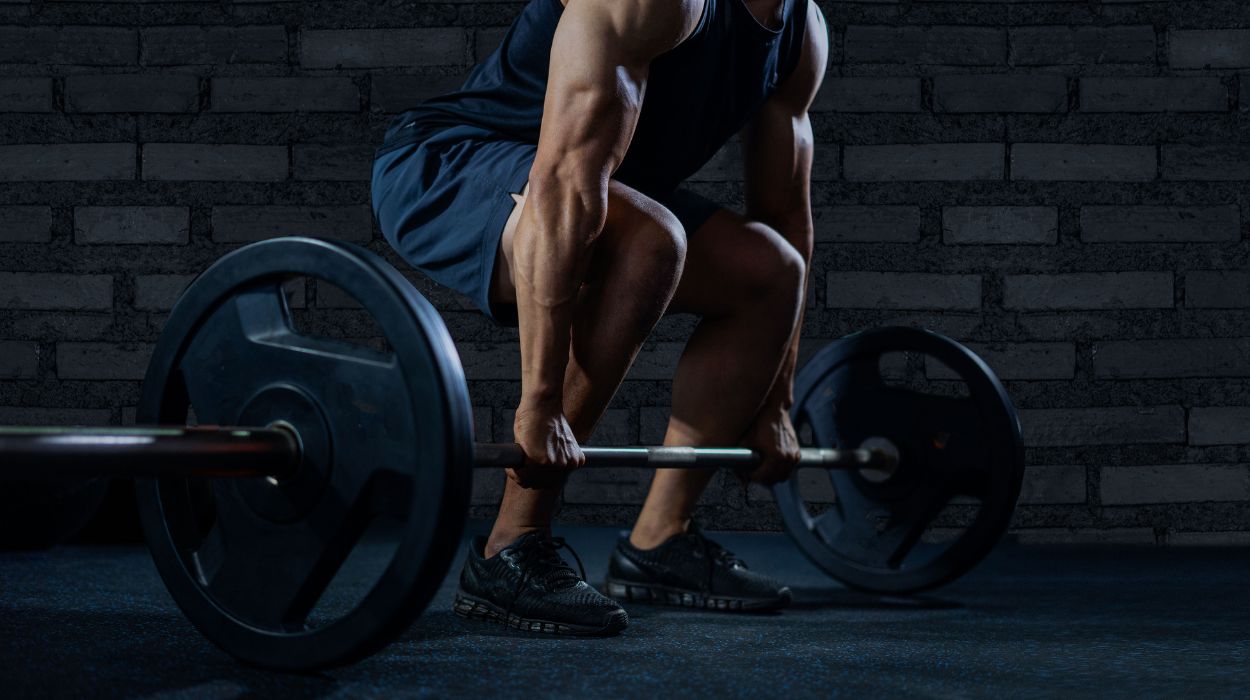
This cannot be emphasized enough. Using the correct form helps prevent injury and ensures you’re effectively targeting the intended muscles. If you’re unsure about the form, consider hiring a personal trainer or seeking advice from a gym instructor.
Start Light
If you’re new to barbell workouts, starting with a weight you can comfortably manage while maintaining good form is crucial. As your strength and technique improve, you can gradually increase your weight.
Breathe Properly
Breathing is crucial in weightlifting. Generally, exhale during the most challenging part of the lift, the exertion phase. Inhale during the easier part, the recovery phase. Never hold your breath, as it can increase blood pressure.
Rest And Recover
Allow your body to rest between sets and workouts. Rest is when the muscles repair and grow stronger. Additionally, stop the exercise if you’re feeling pain or discomfort during a workout. If the pain continues, consult with a healthcare provider.
Hydrate
Always keep a water bottle nearby during your workouts. Staying hydrated[2] helps your body function optimally and can aid in recovery.
Remember, the most effective workout is a safe one. Listen to your body, don’t rush, and focus on the quality of movement over the quantity of weight or repetitions.
The Bottom Line
Whether you want to build muscle or lose weight, ab workouts with barbells can help.
They provide a high-intensity, total-body workout, taking your core stability and strength to the next level.
Safety should always be your top priority — proper form, correct weight selection, adequate rest, and smart habits like taking the necessary vitamins or supplements.
With these practices in place, the journey to a stronger core and better fitness becomes more enjoyable, sustainable, and rewarding. Fitness is not just about the destination but the journey itself.
Frequently Asked Questions
While you can train your abdominal muscles daily, it’s not typically recommended. Like any other muscle group, your abs need time to recover and grow. Stick to ab workouts 2-3 times a week.
Absolutely! Weighted ab exercises, such as those involving barbells, can increase the resistance your muscles work against, which can help build strength and definition.
Yes, while the primary focus of barbell squats is your lower body, your upper body and core muscles are engaged to maintain balance and stability during the lift.
Definitely. Planks[3] are one of the most effective exercises for targeting your entire core, which includes your upper body, abs, obliques, and lower back.
While barbell exercises can help you build muscle and increase your metabolic rate, spot fat reduction isn’t possible.
Not necessarily. The right weight for barbell ab exercises challenges you but allows you to complete your reps properly.
Yes, beginners can start with barbell ab exercises, but it’s crucial to use a manageable weight and to focus on maintaining proper form.
This can vary greatly depending on your starting point, diet, overall fitness routine, and genetics. However, consistency is key. Most people notice strength improvements within a few weeks. Visual changes take a few months.
Resources
- Alaa Khushhal, Nichols, S., Carroll, S., Abt, G. and Ingle, L. (2020). Characterising the application of the ‘progressive overload’ principle of exercise training within cardiac rehabilitation: A United Kingdom-based community programme. PLOS ONE, [online] 15(8), pp.e0237197–e0237197. doi:https://doi.org/10.1371/journal.pone.0237197.
- CDC (2022). Water and Healthier Drinks . [online] Centers for Disease Control and Prevention. Available at: https://www.cdc.gov/healthyweight/healthy_eating/water-and-healthier-drinks.html
- Zahiri, A., Esmaillzadeh, A., Abdolhamid Daneshjoo, Pike, N., Konrad, A. and Behm, D.G. (2022). Core Muscle Activation With Foam Rolling and Static Planks. [online] 13. doi:https://doi.org/10.3389/fphys.2022.852094.




